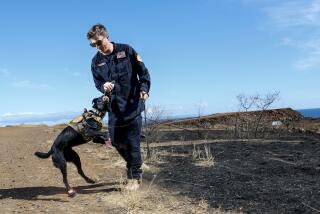Picking Up the Scent From Below : Police Dogs Trained to Detect Underwater Graves
- Share via
MISSION VIEJO — His shoes and socks were found in a car by the lake, but the 21-year-old man had vanished. Police investigators had the grim feeling that he was lying at the bottom of Lake Mission Viejo.
Frogmen from the sheriff’s dive team had begun their slow, methodical sweep of the muddy lake bottom when the latest advancement in underwater detection arrived: Hershe, a brown Labrador retriever and county rescue dog.
Hershe took a few loud sniffs of the lakeside dock and bounded into the cold water. Within minutes of being coaxed back onto a boat, the dog began quivering in excitement, alerting his trainer that the missing man’s scent was nearby.
About 40 feet below the surface of that spot, divers discovered the body of the young man, who had been missing for six days in early March.
“A lot of people, including deputies, still don’t believe it,” Hershe’s handler, Ron Moore, said of the dog’s feat this month. “They come up to me and say, ‘Naaaah, it can’t be.’ ”
Dogs have been used to detect underwater graves for decades by a handful of search and rescue teams.
“The dogs really aren’t doing anything amazing,” said Moore, county forensic scientist. “They’re just doing something that we weren’t aware of yet.”
Only recently, after the development of training methods, has a dubious police community begun to believe.
“Law enforcement people are, by nature, pretty skeptical. You’ve got to show them,” said Bill Tolhurst, chief of special forces for the Niagara County sheriff’s office in New York, who has trained bloodhounds to scent over water since 1975.
The dogs respond to human scents that rise to the surface. Gases are emitted by decomposition and linger on the water surface. Body oils and tissue make their way to the surface as well.
The recent development of chemicals by a St. Louis firm that simulates the odor of death to dogs has quickly advanced the training of search and rescue dogs. Previously, Tolhurst and others had to use human body parts to train their dogs.
“AIDS stopped that pretty quick,” Tolhurst said from New York.
Now, trainers fill a small pipe with synthetic cadaver scent and ink, cap it, drill a few holes and toss it into water. Within minutes, the scent and ink surface.
For Hershe, a boisterous 3-year-old, a successful find means a reward--a round of Frisbee toss with Moore. But for human handlers, it means ending a family’s unbearable uncertainty.
“You want to bring an end to these people’s pain,” said retired county rescue worker Larry Harris, whose bloodhounds also were at Lake Mission Viejo. “It’s the not knowing that’s the worst.”
Using dogs saves time.
Although divers probably would have found the body in their next sweep, “the dogs can cut our time down tremendously if they’re accurate,” said Mark Klopp, a reserve diver for the sheriff’s dive team.
But conditions have to be right. Klopp, who still considers himself a skeptic, has seen dogs pass right by drowning victims.
“I think I’d have to see a couple more to be convinced,” he said.
Fast-running currents can scatter a scent far beyond the dog’s ability to pinpoint the body’s location, Tolhurst said. Extremely cold conditions underwater can slow or halt decomposition, limiting the scent on the water’s surface.
But the water’s depth, Tolhurst says, doesn’t matter.
“Ten or 200 feet, the tissue and scent get to the top the same way,” he said.
Hershe and two bloodhounds, Sable and Duchess, have been training for about a year. Hershe’s success at Lake Mission Viejo was a first for the Orange County Sheriff’s Department.
“The first thing I did was familiarize Hershe with boats,” Moore said. “Then I had to get her used to looking for something on water that she usually finds on land.
“She got a little bit spooked by the divers with all their bubbles,” he said. “But she trained for this very easily.”
Tolhurst has lost count of the bodies his dogs have found over the years, of the families who found bittersweet relief from the news.
But there is one search he has yet to do.
During Upstate New York’s frozen winters, people who have been underwater for up to 45 minutes have been revived, he said.
“I’ve never saved a person like that,” he said. “I’ve never been in the position, because I don’t usually get called until all else fails. But, my, it would be sweet.”
More to Read
Sign up for Essential California
The most important California stories and recommendations in your inbox every morning.
You may occasionally receive promotional content from the Los Angeles Times.










